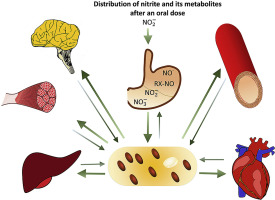当前位置:
X-MOL 学术
›
Free Radical Bio. Med.
›
论文详情
Our official English website, www.x-mol.net, welcomes your
feedback! (Note: you will need to create a separate account there.)
A comprehensive time course study of tissue nitric oxide metabolites concentrations after oral nitrite administration.
Free Radical Biology and Medicine ( IF 7.1 ) Pub Date : 2020-03-07 , DOI: 10.1016/j.freeradbiomed.2020.03.006 Lucas C Pinheiro 1 , Graziele C Ferreira 1 , Célio Damacena de Angelis 2 , Jose Carlos Toledo 3 , Jose E Tanus-Santos 1
Free Radical Biology and Medicine ( IF 7.1 ) Pub Date : 2020-03-07 , DOI: 10.1016/j.freeradbiomed.2020.03.006 Lucas C Pinheiro 1 , Graziele C Ferreira 1 , Célio Damacena de Angelis 2 , Jose Carlos Toledo 3 , Jose E Tanus-Santos 1
Affiliation

|
Nitrite and nitrate are considered nitric oxide (NO) storage pools. The assessment of their tissue concentrations may improve our understanding of how they attenuate pathophysiological mechanisms promoting disease. We hypothesized that significant differences exist when the tissue concentrations of nitrite, nitrate, and nitrosylated species (RXNO) are compared among different tissues, particularly when nitrite is administered orally because nitrite generates various NO-related species in the stomach. We studied the different time-dependent changes in plasma and tissue concentrations of nitrite, nitrate, and RXNO after oral nitrite 15 mg/kg was administered rats, which were euthanized 15, 30, 60, 120, 240, 480 or 1440 min after nitrite administration. A control group received water. Arterial blood samples were collected and the rats were perfused with a PBS solution containing NEM/DTPA to prevent the destruction of RXNO. After perfusion, heart, aorta, mesenteric artery, brain, stomach, liver and femoral muscle were harvested and immediately stored at -70°C until analyzed for their nitrite, nitrate and RXNO contents using an ozone-based reductive chemiluminescence assay. While nitrite administration did not increase aortic nitrite or nitrate concentrations for at least 60 min, both aorta and mesenteric vessels stored nitrite from 8 to 24 h after its administration and their tissue concentrations increased from 10 to 40-fold those found in plasma. In contrast, the other studied tissues showed only transient increases in the concentrations of these NO metabolites, including RXNO. The differences among tissues may reflect differences in mechanisms regulating cellular influx of nitrite. These findings have important pharmacological and clinical implications.
中文翻译:

口服亚硝酸盐后组织一氧化氮代谢产物浓度的综合时程研究。
亚硝酸盐和硝酸盐被视为一氧化氮(NO)储存池。对它们的组织浓度的评估可能会增进我们对它们如何减弱促进疾病的病理生理机制的了解。我们假设在不同组织之间比较亚硝酸盐,硝酸盐和亚硝化物种(RXNO)的组织浓度时存在显着差异,特别是当口服施用亚硝酸盐时,因为亚硝酸盐在胃中产生各种NO相关物种。我们研究了口服亚硝酸盐15 mg / kg大鼠在亚硝酸盐处理后15、30、60、120、240、480或1440分钟安乐死后,血浆和组织中亚硝酸盐,硝酸盐和RXNO的血浆和组织浓度随时间的变化行政。对照组接受水。收集动脉血样品,并向大鼠灌注含有NEM / DTPA的PBS溶液,以防止RXNO的破坏。灌注后,收集心脏,主动脉,肠系膜动脉,脑,胃,肝和股肌,并立即保存在-70°C下,直到使用基于臭氧的还原化学发光分析法分析其亚硝酸盐,硝酸盐和RXNO含量。亚硝酸盐的施用至少在60分钟内不会增加主动脉亚硝酸盐或硝酸盐的浓度,但主动脉和肠系膜血管均在施用后8至24小时内储存亚硝酸盐,其组织浓度从血浆中的10倍增至40倍。相比之下,其他研究组织仅显示这些NO代谢物(包括RXNO)的浓度瞬时增加。组织之间的差异可能反映了调节亚硝酸盐进入细胞的机制的差异。这些发现具有重要的药理和临床意义。
更新日期:2020-03-09
中文翻译:

口服亚硝酸盐后组织一氧化氮代谢产物浓度的综合时程研究。
亚硝酸盐和硝酸盐被视为一氧化氮(NO)储存池。对它们的组织浓度的评估可能会增进我们对它们如何减弱促进疾病的病理生理机制的了解。我们假设在不同组织之间比较亚硝酸盐,硝酸盐和亚硝化物种(RXNO)的组织浓度时存在显着差异,特别是当口服施用亚硝酸盐时,因为亚硝酸盐在胃中产生各种NO相关物种。我们研究了口服亚硝酸盐15 mg / kg大鼠在亚硝酸盐处理后15、30、60、120、240、480或1440分钟安乐死后,血浆和组织中亚硝酸盐,硝酸盐和RXNO的血浆和组织浓度随时间的变化行政。对照组接受水。收集动脉血样品,并向大鼠灌注含有NEM / DTPA的PBS溶液,以防止RXNO的破坏。灌注后,收集心脏,主动脉,肠系膜动脉,脑,胃,肝和股肌,并立即保存在-70°C下,直到使用基于臭氧的还原化学发光分析法分析其亚硝酸盐,硝酸盐和RXNO含量。亚硝酸盐的施用至少在60分钟内不会增加主动脉亚硝酸盐或硝酸盐的浓度,但主动脉和肠系膜血管均在施用后8至24小时内储存亚硝酸盐,其组织浓度从血浆中的10倍增至40倍。相比之下,其他研究组织仅显示这些NO代谢物(包括RXNO)的浓度瞬时增加。组织之间的差异可能反映了调节亚硝酸盐进入细胞的机制的差异。这些发现具有重要的药理和临床意义。











































 京公网安备 11010802027423号
京公网安备 11010802027423号